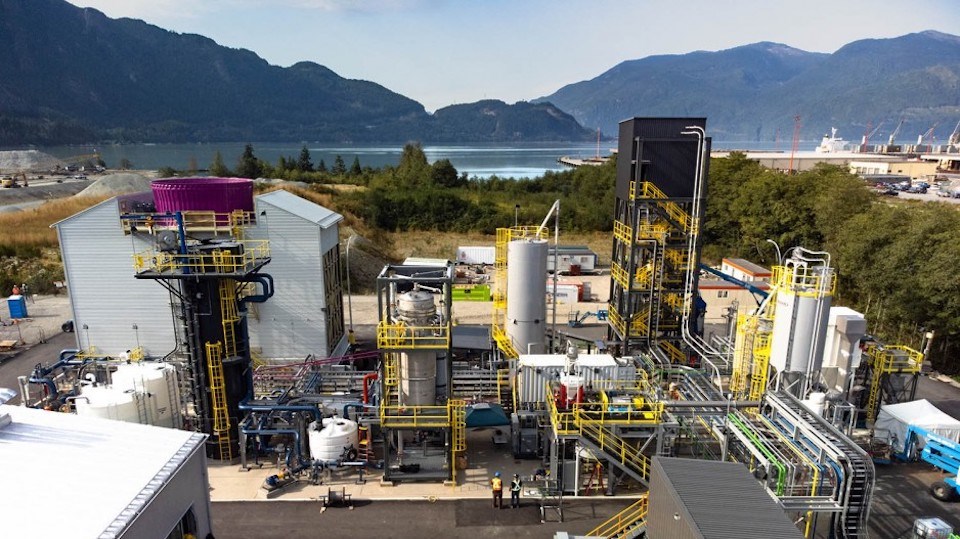Carbon Engineering and its U.S. partner have only just begun building the world’s largest commercial direct air capture project in Texas and are already planning a second project – one with a potential capacity of capturing 30 million tonnes of CO2 annually.
The B.C. based company – one of the leading direct air capture innovators – is already developing a half-million tonne DAC plant in Texas in the Permian Basin, in partnership with 1PointFive, a technology subsidiary of Occidental (NYSE: OXY), an American oil producer.
Carbon Engineering announced yesterday it has been contracted by 1PointFive to begin the front-end planning and engineering for DAC for a second site in Kleberg County, Texas, which will be designed to be scalable.
“The site is expected to provide access for the construction of multiple DAC facilities that would collectively remove up to 30 million tonnes of carbon dioxide from the atmosphere annually for dedicated sequestration,” Carbon Engineering said in a news release.
The first DAC site in Texas is expected to be commissioned in 2024. At an initial 0.5 million tonnes of CO2 captured per year – with a second phase or “train” taking it to 1 million tonnes – it will be the largest DAC plant in the world.
“This first facility, which is only half a megatonne, will be a hundred times bigger than anything else that exists in the world,” Daniel Friedmann, former CEO of Macdonald, Dettwiler & Associates and new CEO of Carbon Engineering, told BIV News.
“And then we’re now talking about doing 30 megatonnes, which will be 60 times bigger than that.”
"When it begins operations in 2024, DAC 1 is set to become the world’s largest direct air capture (DAC) facility," the International Energy Agency (IEA) recently noted of the 1PointFive plant. "This landmark project is an important development that can help demonstrate the valuable and unique role of DAC for meeting net zero goals."
The CO2 captured at the first site could be used either for enhanced oil recovery, or for pure sequestration. The second site announced this week would be for pure geological sequestration.
Because of the energy inputs needed to pull CO2 out of the air, DAC is much more expensive than source-point capture (i.e. capturing CO2 directly from industrial flu stacks). But whereas point source capture makes industries carbon neutral, DAC is considered carbon negative because it would be removing CO2 that is already in the atmosphere.
Until very recently, the economics for DAC with pure sequestration were prohibitively challenging. Unless some value can be found for captured CO2 – using it for enhanced oil recovery, for example – the economics just didn’t work for DAC. But thanks to the Biden Administrations’ new Inflation Reduction Act in the U.S., DAC with pure sequestration may suddenly have a value proposition.
According to the World Resources Institute, the cost of DAC is US$250 to US$600 per tonne of CO2 captured, though projections are the costs could fall to US$150 to US$200 per tonne over the next five to 10 years.
The U.S. already had the 45Q tax credit, which provided significant subsidies for carbon capture and storage investments.
Overnight, the Inflation Reduction Act boosted the 45Q tax credit for DAC from US$50 per tonne to US$180 per tonne for pure sequestration, and from US$35 per tonne to $130 per tonne for DAC-captured CO2 used in enhanced oil recovery.
The 1PointFive business model for its DAC projects also includes selling carbon offsets. Airbus, for example, has purchased 400,000 tonnes of carbon removal credits from 1PointFive for its first DAC project in Texas.
“The government has enabled the math to all work,” Friedmann said. “There’s no doubt that the U.S. legislation is miles ahead of anything in the world, including Canada, and that we’re all going to be building our plants in the U.S., given that legislation.”
As for why Texas is poised to become such a major player in the DAC space, the Lone Star State has a couple of distinct advantages. For one, it has massive amounts of geological storage capacity, both in Texas and next door in Louisiana, thanks to all the old spent oil and gas wells there.
“When you’re looking for the best location the first thing you need to have, you need to have a place to store a lot of carbon,” Friedmann said. “Because we’re not trying to build 1 megatonne – we’re trying to build 30 megatonnes -- and we’re going to run those plants for 20, 30 years, so we have to have a lot of (storage) space.
“The second criteria is we need to run our machines on renewable electricity, otherwise we’re not moving forward.”
DAC requires a fair amount of electricity, and Texas has a substantial amount wind power. About 20% of its power comes from wind. Texas also gets about 11% of its firm power from zero-emission nuclear power.
1PointFive has ambitious plans to build 70 DAC facilities worldwide by 2035.


